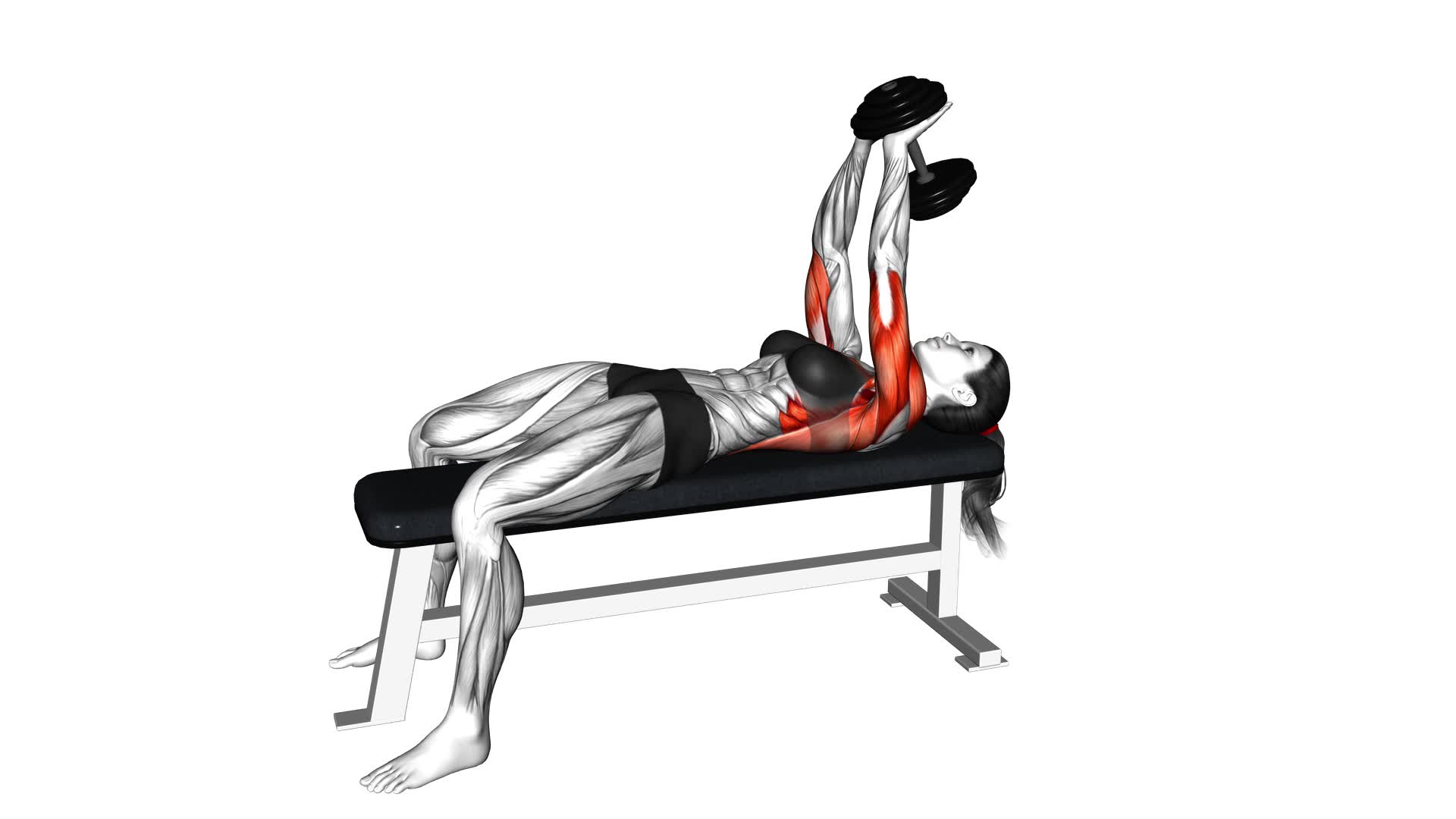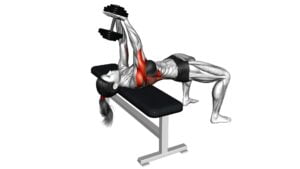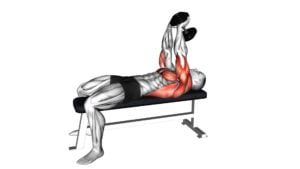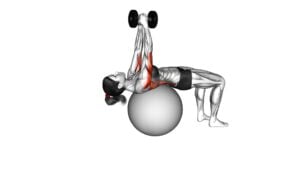Dumbbell Pullover (VERSION 2) (female) – Video Exercise Guide & Tips

Looking to strengthen your upper body? Get ready to try the Dumbbell Pullover (Version 2)!
Watch This Exercise Video
This female-friendly exercise targets key muscles while improving your overall strength and flexibility.
In this video exercise guide, you'll learn the proper form and technique for maximum results. We'll also provide you with variation options to challenge yourself and tips to ensure safety and avoid common mistakes.
Get ready to take your workouts to the next level with the Dumbbell Pullover (Version 2) – let's get started!
Key Takeaways
- Dumbbell Pullover (VERSION 2) targets key muscles in the upper body, improving strength and flexibility.
- It can be incorporated into a well-rounded upper body workout and offers variations to target different muscle groups.
- The exercise focuses on muscles such as the chest, shoulders, and upper back, helping to develop size, strength, and stability in these areas.
- Proper form, breathing techniques, and gradual weight progression are essential for maximizing benefits and minimizing the risk of injury.
Benefits of Dumbbell Pullover (VERSION 2) for Females
Experience the incredible benefits of the Dumbbell Pullover (VERSION 2) as a female, enhancing your strength and toning your upper body.
When it comes to weight selection for the Dumbbell Pullover, it's important to start with a weight that challenges you but allows you to maintain proper form throughout the exercise. As you progress and become stronger, you can gradually increase the weight to continue pushing your limits.
One of the great things about the Dumbbell Pullover (VERSION 2) is that it offers various variations to target different muscles in your upper body. By changing the grip on the dumbbell, you can specifically work your chest, back, or triceps. For example, a pronated grip targets your chest muscles, while a supinated grip primarily works your back muscles. Incorporating these variations into your routine can help you achieve a well-rounded upper body workout.
The Dumbbell Pullover (VERSION 2) is an effective exercise for females looking to improve their strength and tone their upper body. By selecting the right weight and incorporating different variations, you can effectively target different muscle groups and see significant results.
Proper Form and Technique for Dumbbell Pullover (VERSION 2)
To perform the Dumbbell Pullover (VERSION 2) correctly, position yourself on a bench with your feet flat on the floor. Start by lying down with your upper back supported by the bench and your knees bent at a 90-degree angle. Hold a dumbbell with both hands, palms facing upward, and extend your arms straight up above your chest. This is your starting position.
Now, slowly lower the dumbbell behind your head while keeping your arms straight. You should feel a stretch in your chest and shoulders as you do this. Once you reach a comfortable stretch, reverse the movement and raise the dumbbell back to the starting position by contracting your chest muscles. Exhale as you raise the dumbbell and inhale as you lower it.
Maintain control throughout the movement and avoid using momentum to swing the dumbbell. Keep your core engaged and your lower back pressed into the bench to ensure proper form.
Key benefits of the Dumbbell Pullover (VERSION 2) include strengthening the chest, shoulders, and upper back muscles. It also improves shoulder flexibility and stability.
To add variation to this exercise, you can try performing it on an incline bench or using a stability ball instead of a bench. Progressions can include increasing the weight of the dumbbell or performing the exercise with one arm at a time to challenge your muscles further. Remember to always start with a weight that allows you to maintain proper form and gradually increase the intensity as you become stronger.
Key Muscles Targeted by Dumbbell Pullover (VERSION 2)
The Dumbbell Pullover (VERSION 2) primarily targets the chest, shoulders, and upper back muscles, providing a comprehensive upper body workout. Here are the key muscles targeted by this exercise:
- Chest muscles: The dumbbell pullover engages the pectoralis major and pectoralis minor muscles, which are responsible for the horizontal adduction of the arms. This movement helps to develop the size and strength of the chest muscles.
- Shoulder muscles: The anterior deltoid, or front shoulder muscle, is heavily involved in the dumbbell pullover. This exercise also activates the lateral deltoid, or side shoulder muscle, to a lesser extent. Strong and well-developed shoulders contribute to overall upper body strength and stability.
- Upper back muscles: The dumbbell pullover recruits the latissimus dorsi, which is the largest muscle in the back. This exercise also activates the rhomboids and trapezius muscles, which help with scapular retraction and stabilization. Strengthening these muscles can improve posture and support other upper body movements.
To maximize the benefits of the dumbbell pullover and continue progressing, it's important to gradually increase the weight lifted over time. This weight progression challenges the muscles and stimulates further growth and strength development. However, it's crucial to maintain proper form and technique throughout the exercise to avoid injury.
Remember to consult with a fitness professional to determine the appropriate weight progression for your fitness level and goals.
Variation Options to Challenge Your Dumbbell Pullover (VERSION 2) Workout
To challenge your Dumbbell Pullover (VERSION 2) workout, there are several variation options you can try.
First, you can increase the weight progressively to challenge your muscles and improve strength.
Second, focus on maintaining proper form throughout the exercise to maximize its effectiveness and prevent injury.
Lastly, you can target different muscle groups by adjusting your grip or the angle at which you perform the exercise.
Weight Progression Tips
For an effective and challenging dumbbell pullover (VERSION 2) workout, you can vary the weights to progressively increase the difficulty. Weight progression strategies are important to ensure that you're continually challenging your muscles and making progress.
Here are some tips to help you with your weight progression:
- Start with a weight that allows you to complete the exercise with proper form and control.
- Once you can comfortably perform the exercise with that weight, gradually increase the weight in small increments.
- Aim to increase the weight every 1-2 weeks to continually challenge your muscles and promote growth.
Common mistakes to avoid when progressing the weight include:
- Adding too much weight too quickly, which can compromise your form and increase the risk of injury.
- Neglecting to maintain proper form as you increase the weight.
By following these weight progression tips and avoiding common mistakes, you can safely and effectively challenge yourself during your dumbbell pullover (VERSION 2) workout.
Now let's move on to discussing proper form techniques.
Proper Form Techniques
To perform the dumbbell pullover (VERSION 2) with proper form and challenge yourself, try incorporating variation options into your workout.
Proper form is crucial to ensure you target the intended muscles and prevent injury. When performing this exercise, make sure to maintain a stable and controlled movement throughout the entire range of motion. Keep your core engaged and your back flat on the bench.
To challenge yourself, you can increase the weight of the dumbbell gradually as you become stronger. Additionally, you can modify the exercise by performing it on a stability ball instead of a bench. This will require more core stability and engage additional muscles.
Remember to always prioritize good form and consult with a fitness professional for guidance on weightlifting techniques and exercise modifications.
Targeting Different Muscle Groups
To maximize the effectiveness of your dumbbell pullover (VERSION 2) workout and target different muscle groups, incorporate variation options that challenge your muscles in new ways. By incorporating different weightlifting techniques and focusing on specific muscle activation, you can take your dumbbell pullover to the next level.
Here are three variation options to consider:
- Increase the weight: Gradually increase the weight of the dumbbell to challenge your muscles and promote muscle growth.
- Adjust your grip: Alter your grip by using an overhand grip or an underhand grip to engage different muscles in your back and arms.
- Change the angle: Adjust the incline of the bench to target different areas of your chest and upper back.
Tips to Maximize Results From Dumbbell Pullover (Version 2)
To maximize your results from the dumbbell pullover (Version 2), it's important to pay attention to two key points: breathing techniques and proper form and technique.
When performing the exercise, focus on inhaling deeply as you lower the dumbbell behind your head and exhaling forcefully as you bring it back up.
Additionally, make sure to maintain a stable position and engage your core throughout the movement to ensure proper form and maximize the effectiveness of the exercise.
Breathing Techniques During Exercise
Maximize your results from the Dumbbell Pullover (Version 2) by implementing proper breathing techniques during the exercise. Breathing plays a crucial role in strength training, and using the right techniques can help improve your performance and maximize the benefits of this exercise.
Here are some tips to help you improve your breathing during the Dumbbell Pullover (Version 2):
- Focus on deep breathing: Take deep breaths in and out, filling your lungs with oxygen and exhaling fully.
- Coordinate your breath with the movement: Inhale as you lower the dumbbell and exhale as you raise it back up.
- Practice diaphragmatic breathing: Engage your diaphragm by breathing deeply into your abdomen, rather than shallowly into your chest.
By incorporating these breathing techniques, you can enhance your lung capacity, improve oxygen delivery to your muscles, and optimize your performance during the Dumbbell Pullover (Version 2).
Now, let's move on to the next section to explore proper form and technique for this exercise.
Proper Form and Technique
Now, let's continue the discussion on proper form and technique for the Dumbbell Pullover (Version 2) by focusing on how you can maximize your results through correct execution.
To ensure you're maximizing your results, it's important to maintain proper form throughout the exercise. Start by lying flat on a bench with your feet firmly planted on the floor. Hold the dumbbell with both hands and extend your arms overhead.
As you lower the dumbbell behind your head, keep your elbows slightly bent and maintain control throughout the movement. Avoid arching your back or using momentum to lift the weight. By executing the exercise with proper form, you can effectively target your back muscles and achieve the desired results.
Now, let's move on to the next section, where we'll discuss safety precautions and common mistakes to avoid in dumbbell pullover (version 2).
Safety Precautions and Common Mistakes to Avoid in Dumbbell Pullover (VERSION 2)
Ensure proper form and prevent injury during the dumbbell pullover (VERSION 2) exercise by following these safety precautions and avoiding common mistakes.
To ensure your safety and get the most out of your workout, keep the following precautions in mind:
- Start with a weight that you can handle comfortably. Gradually increase the weight as your strength and technique improve.
- Maintain control throughout the movement. Avoid swinging the dumbbell or using momentum to lift it. This can strain your muscles and increase the risk of injury.
- Keep your core engaged and your back flat on the bench throughout the exercise. This helps to stabilize your body and protect your spine.
- Breathe properly during the exercise. Inhale as you lower the dumbbell and exhale as you lift it back up. This helps maintain stability and prevent dizziness or lightheadedness.
Now, let's take a look at some common mistakes to avoid:
- Arching your back excessively during the exercise can lead to strain and discomfort. Keep your back flat and maintain proper form throughout.
- Avoid lowering the dumbbell too far behind your head. This can cause unnecessary stress on your shoulders and increase the risk of injury.
- Don't rush the movement. Slow and controlled repetitions are key to maximizing the benefits of the exercise and minimizing the risk of injury.
Frequently Asked Questions
Can I Do the Dumbbell Pullover Exercise if I Have a Shoulder Injury?
If you have a shoulder injury, it's important to modify exercises to avoid further strain. The dumbbell pullover may not be the best choice for you right now.
Instead, consider alternative exercises that target the same muscle groups, such as lat pulldowns or cable crossovers. These exercises can provide similar benefits without putting excessive stress on your injured shoulder.
Always consult with a healthcare professional before starting any new exercise routine.
How Many Sets and Reps Should I Do for the Dumbbell Pullover Exercise?
To determine the optimal weight and progression for the dumbbell pullover exercise, start with a weight that challenges you but allows you to maintain proper form.
Begin with 2-3 sets of 8-12 reps and gradually increase the weight as it becomes easier.
For variations and modifications, beginners can try using a stability ball or resistance band, while advanced individuals can use heavier weights or incorporate a decline bench.
Always listen to your body and adjust accordingly for your fitness level.
Can I Use a Resistance Band Instead of Dumbbells for the Pullover Exercise?
Yes, you can use a resistance band instead of dumbbells for the pullover exercise.
Using a resistance band as an alternative provides similar benefits to dumbbell training.
Resistance bands offer variable resistance throughout the movement, targeting your muscles in a different way.
They also allow for greater range of motion and can help improve stability.
Experiment with different resistance levels to find the one that challenges you.
Is It Normal to Feel Discomfort in My Chest During the Dumbbell Pullover Exercise?
Feeling discomfort in your chest during the dumbbell pullover exercise isn't uncommon. It could be due to improper form or using weights that are too heavy.
Make sure to maintain proper form throughout the movement and use a weight that allows you to perform the exercise without straining your chest.
If the discomfort persists or becomes painful, it's advisable to consult a fitness professional or your healthcare provider for further guidance.
Can I Incorporate the Dumbbell Pullover Exercise Into My Full-Body Workout Routine?
Yes, you can definitely incorporate the dumbbell pullover exercise into your full-body workout routine.
The dumbbell pullover is a versatile exercise that targets multiple muscle groups, including the chest, back, and shoulders. It helps improve upper body strength, stability, and flexibility.
Incorporating different variations of the dumbbell pullover can add variety and challenge to your workouts. By including this exercise in your routine, you can enjoy the benefits of increased muscle engagement and overall strength development.
Conclusion
In conclusion, the dumbbell pullover (version 2) is an effective exercise for females that targets key muscles in the upper body. By maintaining proper form and technique, maximizing results can be achieved.
Additionally, by incorporating variation options, the workout can be made more challenging. It's important to follow safety precautions and avoid common mistakes to prevent any potential injuries.
Overall, incorporating the dumbbell pullover (version 2) into your fitness routine can help improve strength and tone in the upper body.

Author
Years ago, the spark of my life’s passion ignited in my mind the moment I stepped into the local gym for the first time. The inaugural bead of perspiration, the initial endeavor, the very first surge of endorphins, and a sense of pride that washed over me post-workout marked the beginning of my deep-seated interest in strength sports, fitness, and sports nutrition. This very curiosity blossomed rapidly into a profound fascination, propelling me to earn a Master’s degree in Physical Education from the Academy of Physical Education in Krakow, followed by a Sports Manager diploma from the Jagiellonian University. My journey of growth led me to gain more specialized qualifications, such as being a certified personal trainer with a focus on sports dietetics, a lifeguard, and an instructor for wellness and corrective gymnastics. Theoretical knowledge paired seamlessly with practical experience, reinforcing my belief that the transformation of individuals under my guidance was also a reflection of my personal growth. This belief holds true even today. Each day, I strive to push the boundaries and explore new realms. These realms gently elevate me to greater heights. The unique combination of passion for my field and the continuous quest for growth fuels my drive to break new ground.







